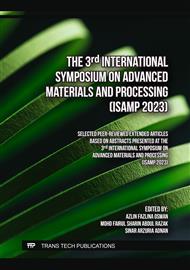[1]
M. Cheng, X. Yan, Y. Cui, M. Han, Y. Wang, J. Wang, R. Zhang, X. Wang, 'Characterization and Release Kinetics Study of Active Packaging Films Based on Modified Starch and Red Cabbage Anthocyanin Extract', Polymers (Basel), vol. 14, no. 6, Mar. 2022.
DOI: 10.3390/polym14061214
Google Scholar
[2]
L. Aliotta, P. Cinelli, M. B. Coltelli, and A. Lazzeri, 'Rigid filler toughening in PLA-Calcium Carbonate composites: Effect of particle surface treatment and matrix plasticization', Eur Polym J, vol. 113, p.78–88, Apr. 2019.
DOI: 10.1016/j.eurpolymj.2018.12.042
Google Scholar
[3]
M. Zam, I. Niyumsut, K. Osako, and S. Rawdkuen, 'Fabrication and Characterization of Intelligent Multi-Layered Biopolymer Film Incorporated with pH-Sensitive Red Cabbage Extract to Indicate Fish Freshness', Polymers (Basel), vol. 14, no. 22, Nov. 2022.
DOI: 10.3390/polym14224914
Google Scholar
[4]
A. F. Osman, L. Siah, A. A. Alrashdi, A. Ul-Hamid, and I. Ibrahim, 'Improving the Tensile and Tear Properties of Thermoplastic Starch/Dolomite Biocomposite Film through Sonication Process', Polymers 2021, Vol. 13, Page 274, vol. 13, no. 2, p.274, Jan. 2021.
DOI: 10.3390/polym13020274
Google Scholar
[5]
J. Prachayawarakorn, S. Chaiwatyothin, S. Mueangta, and A. Hanchana, 'Effect of jute and kapok fibers on properties of thermoplastic cassava starch composites', Mater Des, vol. 47, 2013.
DOI: 10.1016/j.matdes.2012.12.012
Google Scholar
[6]
R. Jeziorska, A. Szadkowska, E. Spasowka, A. Lukomska, and M. Chmielarek, 'Characteristics of Biodegradable Polylactide/Thermoplastic Starch/Nanosilica Composites: Effects of Plasticizer and Nanosilica Functionality', Advances in Materials Science and Engineering, vol. 2018, 2018.
DOI: 10.1155/2018/4571368
Google Scholar
[7]
M. E. Peter, A. A. Dabulo, and T. Gurumurthi, 'Growth and Characterization of Barium Chloride Dihydrate Crystal', International Journal of Science and Research, vol. 2, no. 1, 2018.
Google Scholar
[8]
N. Gokilamani, N. Muthukumarasamy, M. Thambidurai, A. Ranjitha, and D. Velauthapillai, 'Utilization of natural anthocyanin pigments as photosensitizers for dye-sensitized solar cells', J Solgel Sci Technol, vol. 66, no. 2, p.212–219, May 2013.
DOI: 10.1007/s10971-013-2994-9
Google Scholar
[9]
S. Kumar, S. Sharma, V. Kumar, R. Sharma, A. Minhas, and R. Boddu, 'Cruciferous vegetables: a mine of phytonutrients for functional and nutraceutical enrichment', Current Advances for Development of Functional Foods Modulating Inflammation and Oxidative Stress, p.401–426, 2022.
DOI: 10.1016/b978-0-12-823482-2.00020-0
Google Scholar
[10]
A. Mazumder, A. Dwivedi, and J. Du Plessis, 'Sinigrin and its therapeutic benefits', Molecules, vol. 21, no. 4. 2016.
DOI: 10.3390/molecules21040416
Google Scholar
[11]
M. C. Silva-Pereira, J. A. Teixeira, V. A. Pereira-Júnior, and R. Stefani, 'Chitosan/corn starch blend films with extract from Brassica oleraceae (red cabbage) as a visual indicator of fish deterioration', LWT, vol. 61, no. 1, p.258–262, Apr. 2015.
DOI: 10.1016/j.lwt.2014.11.041
Google Scholar
[12]
H. Chi, K. Xu, X. Wu, Q. Chen, D. Xue, C. Song, W. Zhang, P. Wang 'Effect of acetylation on the properties of corn starch', Food Chem, vol. 106, no. 3, 2008.
DOI: 10.1016/j.foodchem.2007.07.002
Google Scholar
[13]
L. F. Hong, L. H. Cheng, C. Y. Lee, and K. K. Peh, 'Characterisation of physicochemical properties of propionylated corn starch and its application as stabiliser', Food Technol Biotechnol, vol. 53, no. 3, 2015.
Google Scholar
[14]
A. F. Osman, A. M. T. L. Ashafee, S. A. Adnan, and A. Alakrach, 'Influence of Hybrid Cellulose/Bentonite Fillers on Structure, Ambient, and Low Temperature Tensile Properties of Thermoplastic Starch Composites', Polym Eng Sci, vol. 60, no. 4, 2020.
DOI: 10.1002/pen.25340
Google Scholar
[15]
M. Ni and B. D. Ratner, 'Differentiating calcium carbonate polymorphs by surface analysis techniques - An XPS and TOF-SIMS study', Surface and Interface Analysis, vol. 40, no. 10, 2008.
DOI: 10.1002/sia.2904
Google Scholar
[16]
A. Silvestri, E. Ataman, A. Budi, S. L. S. Stipp, J. D. Gale, and P. Raiteri, 'Wetting Properties of the CO2-Water-Calcite System via Molecular Simulations: Shape and Size Effects', Langmuir, vol. 35, no. 50, 2019.
DOI: 10.26434/chemrxiv.9809834
Google Scholar



